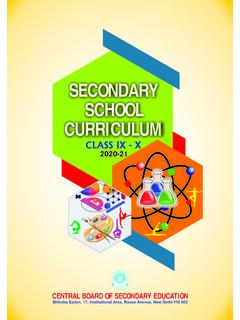Transcription of CHEMISTRY (CLASSES XI –XII) - NCERT
1 1 CHEMISTRY (CLASSES XI XII)RATIONALEH igher Secondary Stage is the most crucial stage of school education because at this stage specialiseddiscipline based, content oriented courses are introduced. Students reach this stage after 10 years ofgeneral education and opt for CHEMISTRY with a purpose of mostly for pursuing their career in basic sciencesor professional courses like medicines, engineering, technology and studying courses in applied areas ofscience and technology at tertiary level. Therefore, at this stage, there is a need to provide learners withsufficient conceptual background of CHEMISTRY , which will make them competent to meet the challenges ofacademic and professional courses after the higher secondary curriculum framework - 2005 recommends a disciplinary approach with appropriate rigourand depth with the care that syllabus is not heavy and at the same time it is comparable to the internationallevel.
2 It emphasizes a coherent focus on important ideas within the discipline that are properly sequencedto optimize learning. It recommends that theoretical component of Higher Secondary Science shouldemphasize on problem solving methods and the awareness of historical development of key concepts ofscience be judiciously integrated into content. The present exercise of syllabus development in Chemistryat Higher Secondary Stage is based on this features of the present syllabus are thus: Some background of CHEMISTRY from secondary stage is assumed; however, no specific knowledgeof topics in CHEMISTRY is pre-supposed. The course is self-contained and broadly covers fundamental concepts of CHEMISTRY . Attempt has been made to see discipline of CHEMISTRY does not remain only the science of factsbut becomes related to modern applications in the world around us.
3 The syllabus provides logical sequencing of the Units of the subject matter with proper placementof concepts with their linkages for better understanding. Emphasis has been on promoting process - skills, problem solving abilities and applications ofconcepts of CHEMISTRY useful in real life situation for making learning of CHEMISTRY more relevant,meaningful and interesting. An effort has been made on the basis of feedback, to remove repetition besides reducing thecontent by suitably integrating the different content areas. Practical syllabus has two components. There are core experiments to be undertaken by thestudents in the classroom and will be part of examination while each student will carry out oneinvestigatory project and submit the report for the examination.
4 With this background, the CHEMISTRY curriculum at the higher secondary stage attempts to promote understanding of basic principles in CHEMISTRY while retaining the excitement in CHEMISTRY ; develop an interest in students to study CHEMISTRY as discipline;2 strengthen the concepts developed at the secondary stage and to provide firm foundation forfurther learning of CHEMISTRY at tertiary level more effectively; develop positive scientific attitude, and appreciate contribution of CHEMISTRY towards theimprovement of quality of human life; develop problem solving skills and nurture curiosity, aesthetic sense and creativity; inculcate values of honesty, integrity, cooperation, concern for life and preservation of theenvironment; make the learner realise the interface of CHEMISTRY with other disciplines of science such as Physics,Biology, Geology, etc; equip students to face challenges related to health, nutrition, environment, population, whetherindustries and XI (THEORY)(Total Periods 180)Unit I: Some Basic Concepts of CHEMISTRY (Periods 14)General Introduction: Importance and scope of approach to particulate nature of matter, laws of chemical combination, Dalton s atomictheory: concept of elements, atoms and and molecular masses.
5 Mole concept and molar mass; percentage composition and empiricaland molecular formula; chemical reactions, stoichiometry and calculations based on II: Structure of Atom(Periods 16)Discovery of electron, proton and neutron; atomic number, isotopes and isobars. Thompson s modeland its limitations, Rutherford s model and its limitations, Bohr s model and its limitations, concept of shellsand subshells, dual nature of matter and light, de Broglie s relationship, Heisenberg uncertainty principle,concept of orbitals, quantum numbers, shapes of s, p and d orbitals, rules for filling electrons in orbitals -Aufbau principle, Pauli exclusion principle and Hund s rule, electronic configuration of atoms, stability ofhalf filled and completely filled III.
6 Classification of Elements and Periodicity in Properties(Periods 8)Significance of classification, brief history of the development of periodic table, modern periodic lawand the present form of periodic table, periodic trends in properties of elements atomic radii, ionic radii,inert gas radii, ionization enthalpy, electron gain enthalpy, electronegativity, valence. Nomenclature ofelements with atomic number greater than IV: Chemical Bonding and Molecular Structure(Periods 16)Valence electrons, ionic bond, covalent bond, bond parameters, Lewis structure, polar character ofcovalent bond, covalent character of ionic bond, valence bond theory, resonance, geometry of covalentmolecules, VSEPR theory, concept of hybridization involving s, p and d orbitals and shapes of somesimple molecules, molecular orbital theory of homonuclear diatomic molecules (qualitative idea only).
7 Hydrogen V: States of Matter: Gases and Liquids(Periods 14)Three states of matter, intermolecular interactions, types of bonding, melting and boiling points,role ofgas laws in elucidating the concept of the molecule, Boyle s law, Charle s law, Gay Lussac s law, Avogadro slaw, ideal behaviour, empirical derivation of gas equation, Avogadro number, ideal gas equation. Kineticenergy and molecular speeds (elementary idea), deviation from ideal behaviour, liquefaction of gases,critical State Vapour pressure, viscosity and surface tension (qualitative idea only, no mathematicalderivations).4 Unit VI: Thermodynamics(Periods 18)Concepts of system, types of systems, surroundings, work, heat, energy, extensive and intensiveproperties, state law of thermodynamics internal energy and enthalpy, heat capacity and specific heat,measurement of U and H, Hess s law of constant heat summation, enthalpy of : bond dissociation,combustion, formation, atomization, sublimation, phase transition, ionization, solution and of entropy as a state function, Second law of thermodynamics, Gibbs energy change forspontaneous and non-spontaneous process, criteria for law of thermodynamics Brief VII.
8 Equilibrium(Periods 20)Equilibrium in physical and chemical processes, dynamic nature of equilibrium, law of mass action,equilibrium constant, factors affecting equilibrium Le Chatelier s principle; ionic equilibrium ionizationof acids and bases, strong and weak electrolytes, degree of ionization, ionization of polybasic acids, acidstrength, concept of pH., Hydrolysis of salts (elementary idea), , buffer solutions, Henderson equation,solubility product, common ion effect (with illustrative examples).Unit VIII : Redox Reactions(Periods 6)Concept of oxidation and reduction, redox reactions, oxidation number, balancing redox reactions interms of loss and gain of electron and change in oxidation numbers , applications of redox IX Hydrogen(Periods 8)Position of hydrogen in periodic table, occurrence, isotopes, preparation, properties and uses ofhydrogen; hydrides ionic, covalent and interstitial; physical and chemical properties of water, heavywater; hydrogen peroxide-preparation, reactions, use and structure.
9 Hydrogen as a X: s- Block Elements (Alkali and Alkaline earth metals)(Periods 14)Group 1 and Group 2 elements:General introduction, electronic configuration, occurrence, anomalous properties of the first elementof each group, diagonal relationship, trends in the variation of properties (such as ionization enthalpy,atomic and ionic radii), trends in chemical reactivity with oxygen, water, hydrogen and halogens; and Properties of Some Important Compounds:Sodium carbonate, sodium chloride, sodium hydroxide and sodium hydrogencarbonate, biologicalimportance of sodium and , CaCO3, and industrial use of lime and limestone, biological importance of Mg and XI: Some p-Block Elements (Periods 16)General Introduction to p-Block ElementsGroup 13 elements: General introduction, electronic configuration, occurrence, variation of properties,oxidation states, trends in chemical reactivity, anomalous properties of first element of the group; Boron-physical and chemical properties, some important compounds: borax, boric acids, boron hydrides.
10 Aluminium:uses, reactions with acids and 14 elements: General introduction, electronic configuration, occurrence, variation of properties,oxidation states, trends in chemical reactivity, anomalous behaviour of first element. Carbon - catenation,allotropic forms, physical and chemical properties; uses of some important compounds: compounds of silicon and a few uses : silicon tetrachloride, silicones, silicates and zeolites,their XII: Organic CHEMISTRY Some Basic Principles and Techniques(Periods 14)General introduction, methods of purification, qualitative and quantitative analysis, classification andIUPAC nomenclature of organic displacements in a covalent bond: inductive effect, electromeric effect, resonance andhyper and heterolytic fission of a covalent bond: free radicals, carbocations, carbanions.

















